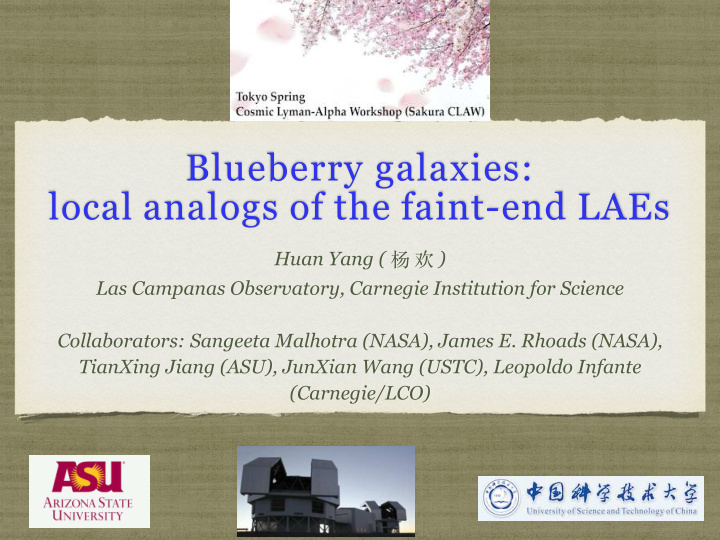



Blueberry galaxies: local analogs of the faint-end LAEs Huan Yang ( 杨 欢 ) Las Campanas Observatory, Carnegie Institution for Science Collaborators: Sangeeta Malhotra (NASA), James E. Rhoads (NASA), TianXing Jiang (ASU), JunXian Wang (USTC), Leopoldo Infante (Carnegie/LCO)
What are the roles of faint-end starbursts during reionization? Drake A.+17 Livermore+17 What are the number densities, faint-end slopes and turn-over luminosities? What fraction of faint UV continuum selected galaxies are strong LyA emitters? What are the leaking Lyman-Continuum luminosities of these faint-end starbursts?
How can we study these faint-end LAEs? HST / JWST / MUSE / KCWI / Narrow-bands (HSC/ DECam) ultra-deep surveys … Are there local analogs of faint-end LAEs?
green peas: local analogs of normal/bright LAEs Green pea luminosity function at z~0.25-0.35 very steep slope α ~ -3.3 Yang,H.+ in-prep.
fainter counterparts of green peas — blueberry galaxies color criteria to select strong [OIII] emission line galaxies at redshift smaller 0.05. Blueberries have 5-10 times smaller distances, therefore at similar apparent magnitudes, blueberry galaxies reached 100 times lower luminosity than green peas. Yang,H.+2017 arXiv:1706.02819
fainter counterparts of green peas — blueberry galaxies a typical optical spectra. The spectra is similar to green peas's, showing strong [OIII] emission lines. [OIII]/Hbeta and [OIII]/ [OII] ratios are also very large. Yang,H.+2017 arXiv:1706.02819 Restframe wavelength [A]
Are blueberries LyA emitters? EW(LyA)=260A fesc(LyA)=0.16 expected Log L(LyA) [erg/s] One blueberry galaxy has HST UV observation and it shows a strong LyA Yang,H.+ in-prep. emission line (also see Jaskot+2017).
Are blueberries LyC leakers? [OIII]/[OII] of blueberries expected fesc(LyC) >~ 15% are ~ 8 - 60. Izotov+2017 [OIII]/[OII] Yang,H.+2017 arXiv:1706.02819
(1): very young low- metallicity starbursts stellar mass around 10^7 solar mass specific star-formation rates ~ 10-100 M yr^-1 very low gas metallicities ~ 3 to 10 percent solar metallicity Yang,H.+2017 arXiv:1706.02819
(2) Are there AGNs and black holes in blueberries? We can not rule out AGN. Kewley+2013 BPT diagram of Blueberry galaxies -2.0 -1.0 0.0 Yang,H.+ in-prep. log([NII]/H α )
(3):Environment — outskirts of galaxy groups Blueberry galaxies are at the very out skirts of galaxy groups. Distance to the nearest Distance to the nearest group center ~ 1 - 4 Mpc galaxy ~ 1 - 4 Mpc Yang,H.+2017 arXiv:1706.02819
(4): HST images Yang,H.+ in-prep. UV HST-F275W Optical HST-F606W 8x8 arcsec cutout SDSS g-r-i SDSS-g NIR HST-F110W
(4): HST images SDSS g-r-i UV HST 8x8 arcsec cutouts Some blueberry galaxies may be mergers of two dwarf systems (galaxies or dark gas clumps). Yang,H.+ in-prep.
Number densities of blueberries in SDSS and HSC candidates! Assuming a model spectra -> M_UV of HSC blueberries ~ -13 to -12. Yang,H.+ in-prep. Are these HSC blueberries faint dwarf galaxies? Or intergalactic star formation regions without underlying dark matter halos?
Summary We calculated the number densities of green peas. We selected blueberry galaxies, which are the local analogs of faint-end LAEs. These blueberries are metal-poor young starbursts in the outskirts of galaxies groups. We selected blueberries in HSC images and are working on the faint-end luminosity function down to Mag ~ -12.
Recommend
More recommend